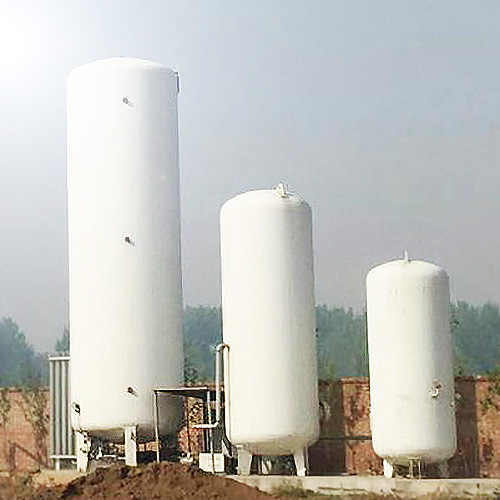Steel storage tank, which used for storing liquid or gas, is important and indispensable for not only the petroleum, chemical, metallurgy, grain, oil, food, transportation and other industries, but also the development of the national economy. For many enterprises, their products cannot be manufactured normally if they don't have storage tanks. Oil storage facilities in China are mostly based on above-ground storage tanks, most of which are metal structure. This article will focus on some basic knowledge of vaulted storage tanks, internal floating roof tanks, and horizontal storage tanks that commonly used in China.
Classification of Storage Tanks
Due to different storage media, the forms of storage tanks are varied:
Classified by location: above-ground storage tanks, underground storage tanks, semi-underground storage tanks, offshore storage tanks, subsea storage tanks, etc.;
By oil types: crude oil storage tanks, fuel storage tanks, lubricating oil storage tanks, edible oil storage tanks, etc.;
By use: storage tanks for production, storage tanks for storing, etc.;
By layout form: vertical storage tanks, horizontal storage tanks, etc.;
By size: large storage tanks (above 100m3, most of which are verical storage tanks), small storage tanks (less than or equal to 100m3, most of which are horizontal storage tanks)
Common Standards of Storage Tanks
American Petroleum Institute API Standard 650, British Standard BS 2654, Japanese Standard JISB 8501, German National Standard DIN 4119, Chinese Petroleum Industry Standard SYJ 1016-82 and Petrochemical Industry Standard SH 3046-92.
Materials of Storage Tanks
The materials required for storage tanks are divided into tank materials and auxiliary facility materials. Materials for tank can be divided into low-strength steel and high-strength steel (mostly used for tanks above 5000m3) according to tensile yield strength or tensile yield strength. Auxiliary facilities (including wind-resistant circle beams, guardrails, etc.) are made by normal carbon structural steel with low strength, and the materials of other accessories depend on different purposes.
Structure of Storage Tanks
At present, the wide used storage tanks in China are vault storage tanks, floating roof storage tanks and horizontal storage tanks, which are also with the most mature production and installation technique.
Structure of the vault storage tanks
A vault storage tank refers to a steel container whose roof is spherical and body is cylindrical. It is an easy-to-manufacture, low-cost tank most commonly used in many industries.
The bottom of vault storage tank is assembled from steel plates, of which the middle of the bottom is center plate while the edge uses bar-shaped or bow-shaped plates. In general, when the inner diameter of the tank is shorter than 16.5m, it is better to use bar-shaped plates, while when that of the tank is longer than or equal to 16.5m, it is better to use bow-shaped plates. The wall of tank is welded by sets of steel plates and can be divided into sleeve type and linear type.
Structure of floating roof storage tanks
A floating roof storage tank is composed of a floating roof on the surface of the medium that rises and falls following the increase or decrease of the storage of the medium, and a vertical cylindrical tank. There is a ring seal between the outer edge of the floating roof and the wall of the tank. The volume of the floating roof is generally large, so the bottom plate is made of a bow-shaped plate. The butt weld of linear tank wall of the floating roof storage tank should be polished to ensure that its inner surface is smooth and flat. The upper part of the floating roof is unenclosed, in order to increase the rigidity of the wall, the windshield ring beam and the reinforcement ring should be set at the top of the tank wall according to the wind load in the area.
The floating roof can be divided into single disc floating roof, double disc floating roof, float type roof, etc. Of which, single disc roof is a ring-shaped float composed of several independent cabins whose inner side of the ring is single-plate. The bottom of single disc floating roof is reinforced by multiple round steel rims, so this kind of roof is low cost and easy-to-maintenance. The double disc floating roof consists of an upper plate, a lower plate and an edge plate. It has advantages such as easy-to-float and good drainage effect.
Structure of internal floating roof tanks
This kind of tank can reduce the volatilization loss of the medium, and its outer vault can prevent rain, snow and dust into the tank to ensure that the medium in the tank is clean. It is mainly used for storing light oil such as gasoline, aviation kerosene, etc. The internal floating roof tank adopts linear tank wall which is butt welded. At present, in China, the floating roof has two structures, one is steel floating roof just like the floating roof storage tank, and the other is assembled aluminum alloy floating roof.
Structure of horizontal tanks
The volume of horizontal tanks are generally less than 100m3, and this kind of tank is usually used in production or gas stations. The ring plates are arranged alternately, taking a single number to make the end caps, which can be divided into flat end caps and disc end caps, the same diameter. The tank with flat end caps is able to withstand 40 kPa of internal pressure, and that with disc end caps can withstand 0.2 Mpa of internal pressure.

